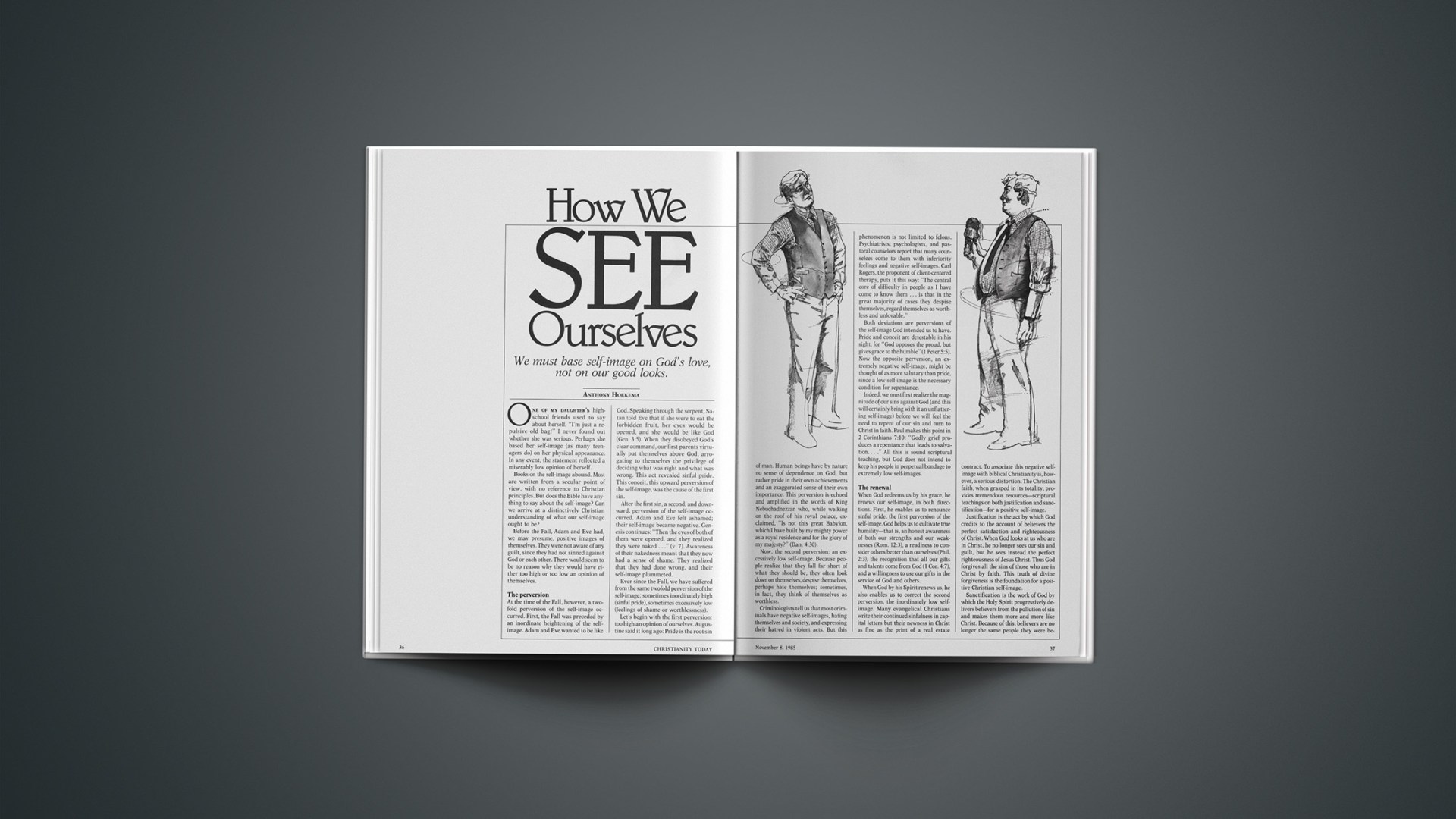We must base self-image on God’s love, not on our good looks.
One of my daughter’s high-school friends used to say about herself, “I’m just a repulsive old bag!” I never found out whether she was serious. Perhaps she based her self-image (as many teenagers do) on her physical appearance. In any event, the statement reflected a miserably low opinion of herself.
Books on the self-image abound. Most are written from a secular point of view, with no reference to Christian principles. But does the Bible have anything to say about the self-image? Can we arrive at a distinctively Christian understanding of what our self-image ought to be?
Before the Fall, Adam and Eve had, we may presume, positive images of themselves. They were not aware of any guilt, since they had not sinned against God or each other. There would seem to be no reason why they would have either too high or too low an opinion of themselves.
The Perversion
At the time of the Fall, however, a twofold perversion of the self-image occurred. First, the Fall was preceded by an inordinate heightening of the self-image. Adam and Eve wanted to be like God. Speaking through the serpent, Satan told Eve that if she were to eat the forbidden fruit, her eyes would be opened, and she would be like God (Gen. 3:5). When they disobeyed God’s clear command, our first parents virtually put themselves above God, arrogating to themselves the privilege of deciding what was right and what was wrong. This act revealed sinful pride. This conceit, this upward perversion of the self-image, was the cause of the first sin.
After the first sin, a second, and downward, perversion of the self-image occurred. Adam and Eve felt ashamed; their self-image became negative. Genesis continues: “Then the eyes of both of them were opened, and they realized they were naked …” (v. 7). Awareness of their nakedness meant that they now had a sense of shame. They realized that they had done wrong, and their self-image plummeted.
Ever since the Fall, we have suffered from the same twofold perversion of the self-image: sometimes inordinately high (sinful pride), sometimes excessively low (feelings of shame or worthlessness).
Let’s begin with the first perversion: too high an opinion of ourselves. Augustine said it long ago: Pride is the root sin of man. Human beings have by nature no sense of dependence on God, but rather pride in their own achievements and an exaggerated sense of their own importance. This perversion is echoed and amplified in the words of King Nebuchadnezzar who, while walking on the roof of his royal palace, exclaimed, “Is not this great Babylon, which I have built by my mighty power as a royal residence and for the glory of my majesty?” (Dan. 4:30).
Now, the second perversion: an excessively low self-image. Because people realize that they fall far short of what they should be, they often look down on themselves, despise themselves, perhaps hate themselves; sometimes, in fact, they think of themselves as worthless.
Criminologists tell us that most criminals have negative self-images, hating themselves and society, and expressing their hatred in violent acts. But this phenomenon is not limited to felons. Psychiatrists, psychologists, and pastoral counselors report that many counselees come to them with inferiority feelings and negative self-images. Carl Rogers, the proponent of client-centered therapy, puts it this way: “The central core of difficulty in people as I have come to know them … is that in the great majority of cases they despise themselves, regard themselves as worthless and unlovable.”
Both deviations are perversions of the self-image God intended us to have. Pride and conceit are detestable in his sight, for “God opposes the proud, but gives grace to the humble” (1 Peter 5:5). Now the opposite perversion, an extremely negative self-image, might be thought of as more salutary than pride, since a low self-image is the necessary condition for repentance.
Indeed, we must first realize the magnitude of our sins against God (and this will certainly bring with it an unflattering self-image) before we will feel the need to repent of our sin and turn to Christ in faith. Paul makes this point in 2 Corinthians 7:10: “Godly grief produces a repentance that leads to salvation.…” All this is sound scriptural teaching, but God does not intend to keep his people in perpetual bondage to extremely low self-images.
The Renewal
When God redeems us by his grace, he renews our self-image, in both directions. First, he enables us to renounce sinful pride, the first perversion of the self-image. God helps us to cultivate true humility—that is, an honest awareness of both our strengths and our weaknesses (Rom. 12:3), a readiness to consider others better than ourselves (Phil. 2:3), the recognition that all our gifts and talents come from God (1 Cor. 4:7), and a willingness to use our gifts in the service of God and others.
When God by his Spirit renews us, he also enables us to correct the second perversion, the inordinately low self-image. Many evangelical Christians write their continued sinfulness in capital letters but their newness in Christ as fine as the print of a real estate contract. To associate this negative self-image with biblical Christianity is, however, a serious distortion. The Christian faith, when grasped in its totality, provides tremendous resources—scriptural teachings on both justification and sanctification—for a positive self-image.
Justification is the act by which God credits to the account of believers the perfect satisfaction and righteousness of Christ. When God looks at us who are in Christ, he no longer sees our sin and guilt, but he sees instead the perfect righteousness of Jesus Christ. Thus God forgives all the sins of those who are in Christ by faith. This truth of divine forgiveness is the foundation for a positive Christian self-image.
Sanctification is the work of God by which the Holy Spirit progressively delivers believers from the pollution of sin and makes them more and more like Christ. Because of this, believers are no longer the same people they were before conversion. They are changed—a second reason why Christians should have primarily positive self-images.
One aspect of this change involves the new self. Should a Christian look upon himself or herself as being both an “old self” (or “old man”) and a “new self” (or “new man”)? No, says Colossians 3:9–10: “Do not lie to each other, since you have taken off your old self with its practices and have put on the new self, which is being renewed in knowledge in the image of its Creator” (NIV). By “old self” Paul means the total person enslaved by sin, whereas by “new self” he means the total person ruled by the Holy Spirit. To these Colossian believers Paul is saying: Since you have become one with Christ you are no longer slaves to sin, having taken off the old self and put on the new. You should therefore look on yourselves not as both old and new selves, but simply as new selves.
This new self which has been put on, however, “is being renewed.” So the new self is not yet perfect, but is being continually renewed. (The Greek verb is in the present tense, suggesting continuing action.)
Believers should, therefore, look on themselves as genuinely new though not yet totally new.
A second aspect of this changed existence involves life in the Spirit. In Romans 8, after having contrasted the “mind of the flesh” with the “mind of the Spirit,” Paul tells his Christian readers: “But you are not in the flesh, you are in the Spirit …” (v. 9). By flesh here Paul does not mean the body, but rather the tendency within fallen humanity to disobey God in every area of life—mental and physical. Flesh in this sense is roughly equivalent to “indwelling sin.”
Though believers must still contend with “indwelling sin” as long as they are in this life, Paul here says plainly that they are no longer in the flesh (that is, enslaved to the flesh) but in the Spirit (that is, under the liberating regime of the Holy Spirit). Instead of still being totally dominated and controlled by the flesh, they are now being directed by the Spirit into a way of life that is pleasing to God and helpful to others. So once again a positive self-image emerges.
A third aspect of this change is the New Testament’s description of the believer as a new creature: “Therefore, if anyone is in Christ, he is a new creation [or new creature,KJV, NASB]: the old has passed away, behold, the new has come” (2 Cor. 5:17). According to this passage, the person who is in Christ is a member of God’s new creation. He or she belongs no longer to the old era of enslavement to sin but to the new era of salvation, joy, and peace inaugurated by Christ’s resurrection. The believer is therefore in a very real sense a new creature.
Commonly we apply the concept “the new creation” only to the life to come. To be sure, the full implications of this new creaturehood will not be revealed until we will have been raised in glory and will be living on the new earth. But 2 Corinthians 5:17 is in the present tense. Paul says, You are new creatures now! And we who are believers should see ourselves as those who have been created anew in Christ Jesus.
The Christian life involves not just believing something about Christ, but also believing something about ourselves. We must accept the fact that we are indeed part of Christ’s new creation. Our faith in Christ must include believing that we are what the Bible says we are.
The Implications
All this implies that the Christian believer may and should have a self-image that is primarily positive. Such a positive self-image does not mean “feeling good about ourselves” on the basis of our own achievements, good looks, or virtuous behavior. This would be sinful pride. And it is the way of the world. The Christian self-image requires looking at ourselves in the light of God’s loving work of forgiveness and renewal. It involves giving God all the praise for what he by his grace has done—and is still doing—in us and through us. It includes confidence that God can use us, despite our shortcomings, to advance his kingdom and to bring joy to others.
This Christian self-image is the opposite of spiritual pride. It goes hand in hand with a deep conviction of sin and a recognition that we are still far from what we ought to be. It means glorying not in self, but in Christ.
The Christian self-image is never an end in itself. It is always a means to the end of living for God and for others. It delivers us from preoccupation with ourselves and releases us so that we may happily serve God and love others.
Our self-image must, therefore, not be static but dynamic. Believers must never be satisfied with themselves. They must always be pressing on, in the strength of Christ, toward the goal of Christian perfection. Christians should see themselves as new persons who are being progressively renewed by the Holy Spirit.
Sometimes airplane pilots cannot be sure whether they are flying upside down or right side up. At such times, they can check their instruments to find out which way is up. When life’s flight is too smooth, or the ride is too rough, and Christians confuse up with down, they can get their bearings by looking at Scripture and remembering who they really are.










